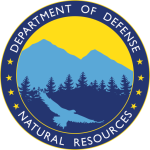To see deliverables resulting from fully executed Legacy projects, visit the Legacy Project Deliverables page: https://www.denix.osd.mil/legacy/nr-legacy-project-deliverables/
About Pollinators
Birds, bees, bats, and other pollinators are in significant decline across the country and around the world. Yet, nearly 80% of the world’s crops require pollination, including fruits, vegetables, chocolate, and tequila. Without pollinators, there would be no tomato salads, no strawberry smoothies, no Hershey’s Kisses™, and no margaritas. One out of every three mouthfuls of food we eat and beverages we drink is the result of pollinator activity. In the United States, insects pollinate crops that produce between $20 billion and $30 billion worth of products annually!
National Strategy To Promote The Health Of Honey Bees And Other Pollinators
Why are Pollinators Important to DoD?
![]() Pollinators are vital to installation landscapes and to carrying out the military mission. Many of the federally-listed and at-risk species located on military installations are pollinators, including species of bees, bats, butterflies, and flowering plants that require pollination.
Pollinators are vital to installation landscapes and to carrying out the military mission. Many of the federally-listed and at-risk species located on military installations are pollinators, including species of bees, bats, butterflies, and flowering plants that require pollination.
![]() Without pollinators, native landscapes might become barren, or be overrun by invasive species. Declines of at-risk species might translate into access restrictions, which in turn could reduce the military’s capacity to test and train.
Without pollinators, native landscapes might become barren, or be overrun by invasive species. Declines of at-risk species might translate into access restrictions, which in turn could reduce the military’s capacity to test and train.
![]() Diverse native plant communities are frequently more resilient to impacts from training activities than poorer quality habitats. Native plant communities (which may depend heavily on pollinators) resist erosion from tank maneuvers, are resilient to fire, and provide realistic and safe training environments for soldiers.
Diverse native plant communities are frequently more resilient to impacts from training activities than poorer quality habitats. Native plant communities (which may depend heavily on pollinators) resist erosion from tank maneuvers, are resilient to fire, and provide realistic and safe training environments for soldiers.
![]() To meet both its readiness and stewardship obligations, DoD cares about pollinators and works to benefit their populations.
To meet both its readiness and stewardship obligations, DoD cares about pollinators and works to benefit their populations.
DoD Funded Projects
DoD has been involved in promoting pollinator and pollinator habitat conservation efforts on its lands for 15 years.
Guidance
Armed Forces Pest Management Board Pollinator Materials
Armed Forces Pest Mgmt Board Technical Guide No. 9, DoD Pollinator Conservation Ref Guide
U.S. Air Force Pollinator Conservation Reference Guide

